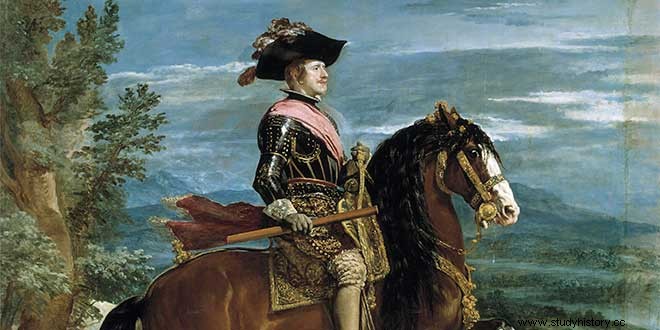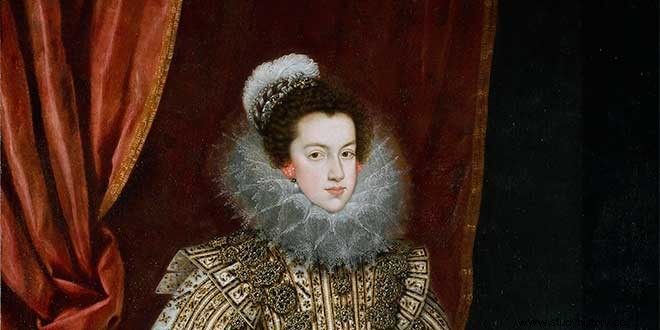Philip IV was king of the crowns of Castile and Aragon. He was born on April 8, 1605 in Valladolid . He was the son of Felipe III and his wife Margarita de Austria. Philip IV came to the throne on the death of his father. From the age of ten, he was entrusted to the care of Don Gaspar de Guzmán (Count-Duke of Olivares), who instilled in him a love of pleasure; Therefore, as soon as he was proclaimed king, he left the Government of his States in the hands of Don Gaspar, whom he appointed Prime Minister, to dedicate himself to hunting, amusements and palatial love affairs. Olivares quickly got rid of all those who had participated in the Government of the previous reign; he made Rodrigo Calderón die on the scaffold.
War with the netherlands
In 1621, he concluded the twelve-year truce with the Netherlands, and the war resumed; the French minister Richelieu encouraged this war in order to weaken the power of the House of Austria; Denmark and England also helped the Dutch. The Marquis of Spínola achieved certain victories, among which is the surrender and capture of the city of Breda in 1626 (motive for the painting of Las Lamas, by Velázquez). Spínola having died, he was succeeded, in the direction of that war, by the Count of Berg, who, after a series of conspiracies, was deposed; He was succeeded by the Marquis of Santa Cruz, who lost the Plaza de Maestrich in 1632; After a series of unfavorable events for Spain, Philip IV recognized the independence of the united provinces of Holland on June 5, 1648 in the Peace of Westphalia; in this peace, the Thirty Years' War, in which Spain had participated supporting Fernando II, also ended; the negotiations ended on October 24, 1648, and the peace treaty was signed in the Council room of the Town Hall of Munster (a German city in the Prussian province of Westphalia).
Diseases and internal wars
On the other hand, between 1629 and 1630, the “Milanese plague” took place , which affected the Mediterranean coast, causing numerous deaths; and, in 1647, another plague spread through the same places:the city of Valencia lost 20% of its population, and Seville, half of its inhabitants. Because of the Count-Duke of Olivares, a war began in Catalonia in June 1640 against the army of Felipe IV, who had just fought against the French in Roussillon; The Catalans declared themselves independent, asked the French for help and appointed Louis XIII of France as Count of Barcelona, who helped them with men and money. The war lasted until October 1652; Felipe IV granted, to Catalonia, the old privileges of him . On the other hand, a few months after this war began, the Count-Duke of Olivares ordered the Portuguese to go to it; this resulted in an insurrection breaking out in Lisbon on December 1, 1640; the conspirators proclaimed the Duke of Braganza king with the name of Juan IV, who marched from Villaviciosa to Lisbon, where he was crowned with great solemnity; at once he was recognized by the European Courts with the exception of Rome. The Spanish resorted to arms; but the Portuguese helped by the French and, later, also by the English, managed to break with the Crown of Castile. In January 1643, the Count-Duke of Olivares lost power; His nephew Luis Méndez de Haro replaced him .

War with France
Despite the peace of Westphalia, the French minister Mazarin, who succeeded Richelieu, demanded that Spain hand over, to France, certain cities in the Netherlands, Franche-Comté and Roussillon, for which the war began with France; This war ended in 1659 with the Peace of the Pyrenees, through which Spain ceded to France the counties of Roussillon, Conflanc, Artois and many places in Flanders; In addition, it was agreed that the French king, Louis XIV, would marry María Teresa, eldest daughter of Felipe IV, after her resignation (for herself and for her descendants) to the succession of the Crowns of Castile and Aragon. Felipe IV died on September 17, 1665 in Madrid, having left by will, his heir to his son, Carlos; and excluding, as heirs, the children of María Teresa.
Marriages and descendants of Felipe IV
In 1615, the marriage of Felipe IV with Isabel de Borbón was arranged (1603-1644, daughter of Henry IV of France and his wife, Marie de' Medici); this marriage was consummated on November 25, 1620; from him were born:Baltasar Carlos (died at 14 years of age), María Teresa (married to Luis XIV of France) and several more children who died in infancy. In 1649, Philip IV married Mariana of Austria for the second time (1634-1696, daughter of Emperor Ferdinand III and his wife, Maria Anna of Austria). Mariana had been promised, in 1648, to Prince Baltasar Carlos (son of Felipe IV); but, due to his death, her marriage could not be consummated, so the following year, Philip IV married her; Carlos II and Margarita (married Leopold I of Germany) were born from this marriage. On the other hand, Felipe IV also left several natural children, and Juan José de Austria, a bastard son (born in 1629 and died in 1679), due to his love affairs with the comedian María Calderón (La Calderona). About this king, it is said:“As a Catholic King, he had the right to enter the cloistered convents and sometimes, captivated by a beautiful nun, he ordered that they prepare her in bed dressed in a blue and white Immaculate Conception dress. .” . In the midst of so much decadence and relaxation of this reign, the Letters and the Arts reached a great splendor; Flourished at this time:Lope de Vega, Calderón de la Barca, Tirso de Molina, Ruiz de Alarcón, Rojas, Góngora, Gracián, Rodrigo Caro, Quevedo, Velázquez, Murillo, Ribera, Zurbarán, Montañés, Alonso Cano , etc.

